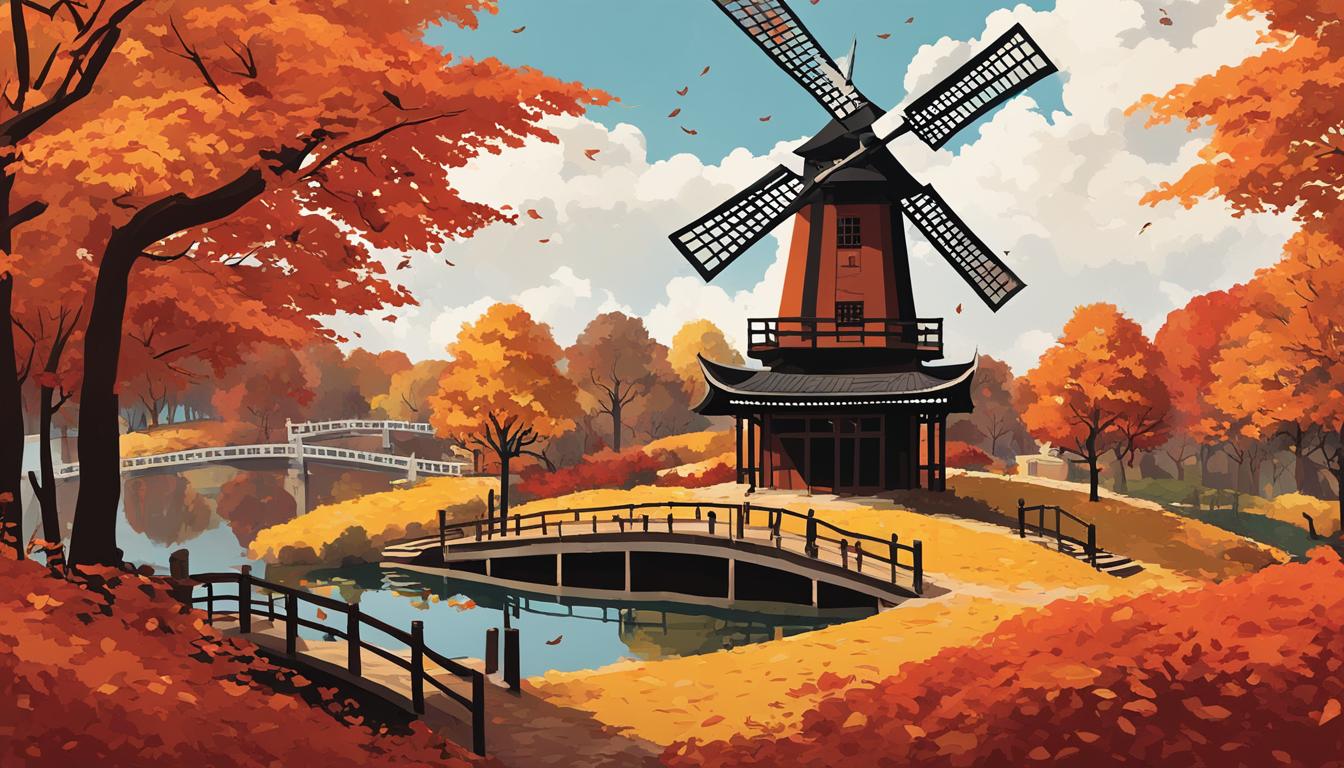If you’re a fan of historical novels, then “The Thousand Autumns of Jacob de Zoet” by David Mitchell is a must-read. This book follows the story of a young Dutch clerk named Jacob de Zoet, who travels to Dejima island in Japan to make his fortune. Along the way, he falls in love with a Japanese midwife named Orito Aibagawa and the two face cultural clashes, political intrigue, and personal dangers.
What’s more, “The Thousand Autumns of Jacob de Zoet” has also been adapted into an audiobook, allowing you to immerse yourself in David Mitchell’s vivid writing while enjoying the convenience of an audio format. In this audiobook review, we’ll explore the plot, characters, themes, and writing style of this historical masterpiece, as well as its narration and reception.
Key Takeaways:
- “The Thousand Autumns of Jacob de Zoet” is a captivating historical novel by David Mitchell.
- The book follows the story of a Dutch clerk named Jacob de Zoet in 18th century Japan.
- The audiobook version of the novel is a great way to immerse oneself in Mitchell’s vivid writing.
- The novel is known for its rich historical setting, compelling characters, and complex themes.
- Readers have praised the novel’s immersive storytelling, impeccable research, and vivid prose.
About the Author
David Mitchell is a British author born in south Worcestershire in 1969. After completing his studies in English and American Literature at the University of Kent, he worked as an English teacher in Sicily, Japan, and the UK. Mitchell’s first novel, “Ghostwritten,” was published in 1999, followed by “number9dream” and “Cloud Atlas,” which were both shortlisted for the Man Booker Prize. His other works include “Black Swan Green,” “The Bone Clocks,” and “Slade House.” Mitchell has been awarded numerous prizes for his literary achievements, including the John Llewellyn Rhys Prize and the World Fantasy Award. He is recognized for his ability to intricately weave together complex narratives and themes, while also drawing on a vast range of literary and historical influences.
“You go on. You just go on. There’s nothing more to it, and there doesn’t need to be.” – David Mitchell
Plot Summary
Set in the late 18th century, “The Thousand Autumns of Jacob de Zoet” follows the journey of Jacob, a young Dutch clerk sent to a trading post on the coast of Japan. In love with a Japanese midwife, Orito, Jacob uncovers corruption and mysteries within the trading post. The story unravels through various plot twists, including Jacob’s capture and rescue, his love for Orito, and a political uprising. The novel culminates in a dramatic and satisfying resolution that leaves readers captivated until the final pages.
This historic masterpiece by David Mitchell is a beautifully crafted story that intertwines various themes such as love, power, and cultural clash. The plot of “The Thousand Autumns of Jacob de Zoet” is meticulously designed to lead readers on an enchanting journey through the bizarre, tragic, and ultimately triumphant events that befall the characters.
“The way to paradise is through hell.” – David Mitchell, The Thousand Autumns of Jacob de Zoet
Setting
One of the most enthralling aspects of “The Thousand Autumns of Jacob de Zoet” is its rich historical setting. David Mitchell expertly transports readers to 18th century Japan, a time of cultural isolation, political intrigue, and economic expansion. Through vivid descriptions of the Dutch trading post Dejima and the bustling city of Nagasaki, Mitchell paints a detailed and immersive portrait of a bygone era. He seamlessly weaves together real-life events and characters with fictional elements, creating a world that feels both authentic and fantastical.
The setting serves as not only a backdrop but a character in itself, shaping the actions and beliefs of the novel’s diverse cast of characters. Mitchell masterfully captures the cultural clash between the rigid Japanese society and the pragmatic Dutch merchants, highlighting the stark differences and occasional similarities between the two worlds. The historical setting is not just a means to an end but an integral part of the story, heightening the stakes and adding layers of meaning and resonance to the narrative.
The Dutch Trading Post Dejima
| Location | Population | Function |
|---|---|---|
| Off the coast of Nagasaki, Japan | Only a handful of Dutch officials and traders, along with some Japanese interpreters and servants | Only place where the Dutch and Japanese can exchange goods and communicate with each other, as Japan otherwise prohibits any foreign contact or influence. |
The City of Nagasaki
- Japan’s only window to the outside world at the time
- A bustling hub of trade, cultural exchange, and innovation
- Home to various communities, including Dutch, Chinese, Korean, and Portuguese traders, as well as Japanese officials, samurais, merchants, and commoners
“Mists of smoke. Smells of grilling fish and frying eggs. Panes of glass shine. Vanity towers. The street is fearfully busy. Cobbled. Uneven. Umbrella makers. Fan makers. Smithies. Cabinetmakers. Shrines. Bookstores. Theatres. Stalls. More people than one can safely jostle among.” – David Mitchell, “The Thousand Autumns of Jacob de Zoet”
Characters
In “The Thousand Autumns of Jacob de Zoet,” David Mitchell brings to life a diverse cast of characters, each with their own unique stories and motivations. At the center of the narrative is Jacob de Zoet, a young clerk of the Dutch East India Company stationed in Dejima, Japan. Jacob is a man of principle and integrity, who fights against corruption and injustice despite the overwhelming odds.
Other notable characters in the novel include:
| Name | Description |
|---|---|
| Miss Aibagawa | A young Japanese midwife who captures Jacob’s heart with her intelligence and bravery |
| Orito Aibagawa | A Japanese student of Dutch medicine who faces numerous challenges and obstacles throughout the novel |
| Magistrate Shiroyama | A Japanese official who works closely with Jacob and becomes a close friend and ally |
| Abel Verghese | A Parsi opium addict and former sailor who provides crucial assistance to Jacob |
Each character is expertly crafted by Mitchell, with complex backstories and well-drawn personalities that make them feel like real people. Through their interactions and conflicts, “The Thousand Autumns of Jacob de Zoet” presents a rich tapestry of human experience and an exploration of the complex dynamics of power, identity, and culture.
Writing Style
David Mitchell’s writing style in “The Thousand Autumns of Jacob de Zoet” is characterized by its vivid imagery, lyrical language, and intricate narrative techniques. Mitchell’s mastery of language allows him to paint a rich and nuanced portrait of his characters and their world, weaving together historical details and fictional storytelling with precision and depth.
One of Mitchell’s signature techniques is his use of shifting perspectives, allowing readers to experience the story through the eyes of multiple characters and gain a more complete understanding of their motivations and perspectives. This technique is particularly effective in “The Thousand Autumns of Jacob de Zoet,” as it allows readers to experience the cultural clash between the Dutch traders and the Japanese inhabitants of Dejima from multiple angles.
“Mitchell’s writing has a kind of contagious enthusiasm; he writes in such a way that the joy he experiences in telling his stories spills over to the reader.” – The Los Angeles Times
The imagery in “The Thousand Autumns of Jacob de Zoet” is also striking, with Mitchell using vivid descriptions of the natural world and its inhabitants to create a sense of place and atmosphere. This attention to detail extends to Mitchell’s use of historical settings, with the novel’s intricate portrayal of life in the waning days of the Dutch East India Company adding a layer of authenticity and depth to the story.

Overall, David Mitchell’s writing style in “The Thousand Autumns of Jacob de Zoet” is a testament to his skill as a writer and his ability to create powerful, immersive experiences for his readers.
Themes
“The Thousand Autumns of Jacob de Zoet” is more than just a historical novel, it’s a deep exploration of complex themes and hidden messages. The story touches upon different topics such as love, power, and cultural clash.
One of the most prominent themes in the book is the clash between cultures. David Mitchell portrays the cultural differences and misunderstandings between the Dutch and the Japanese with a unique sensitivity that exposes the complexity and humanity of both cultures. This theme is brought to the forefront through the interactions between Jacob de Zoet and Orito Aibagawa, two characters representing different cultures, traditions and values.
The theme of power is also present in the book. The Dutch and the Japanese struggle for control and dominance over the trade route and the land. The characters use every tool at their disposal to gain leverage and assert their authority, including violence, manipulation, and bribery. This struggle for power not only drives the plot forward but also represents a deeper commentary on human nature and the corrupting influence of power.
Finally, love is a central theme in the book. Mitchell deftly portrays the different kinds of love that exist within the story, from the love between romantic partners, to love amongst friends and family, as well as the love for a cause or belief. Love, in its multiple forms, serves as a unifying force that guides the complex web of relationships and emotions within the narrative.
“The Thousand Autumns of Jacob de Zoet” is a remarkable novel that delves deep into the human experience and uncovers profound truths about love, power, and culture. Through its intricate and nuanced themes, the book presents a powerful message about our shared humanity and the universality of our struggles and desires.”
Narration
The audiobook narration of “The Thousand Autumns of Jacob de Zoet” brings the story to life with skill and nuance. Narrator Jonathan Aris captures the unique voices and accents of the diverse cast of characters, immersing the listener in the rich historical setting. Aris’s pacing and tone create a sense of tension and build-up, expertly handling the novel’s shifts in perspective and timeline.
The use of sound effects and music also adds to the overall reading experience, enhancing the mood and atmosphere of the story. The audiobook version is a great option for those who want to experience the novel in a different way or for those who prefer a more immersive storytelling experience. However, some listeners may find the sound effects distracting or unnecessary.
“The audiobook version is a great option for those who want to experience the novel in a different way or for those who prefer a more immersive storytelling experience.”
Table 8.1: Pros and Cons of Audiobook Narration
| Pros | Cons |
|---|---|
| Enhanced immersion in the story | Sound effects and music may be distracting |
| Voice acting brings characters to life | May not accurately convey author’s intended tone or pacing |
| Easier for listeners with visual impairments or busy schedules | Requires a subscription to an audiobook service or additional purchase |
In conclusion, the audiobook narration of “The Thousand Autumns of Jacob de Zoet” adds a new dimension to the reading experience, bringing the story to life with expert voice acting and sound effects. While some listeners may find the additional elements distracting, the audiobook version is a great option for those who prefer a more immersive storytelling experience or have difficulty with traditional reading formats.
Reception
Since its publication, “The Thousand Autumns of Jacob de Zoet” has received critical acclaim for its meticulous historical research, intricate plot, and memorable characters. The novel was shortlisted for the Man Booker Prize in 2010, and it was also named one of the 100 best books of the decade by The Times and The Independent.
The novel’s vivid depiction of Japan’s isolationist society in the late eighteenth century has been praised for its immersive detail and cultural sensitivity. The New York Times’ Janet Maslin wrote that Mitchell “paints an achingly clear picture of the closed and hierarchical society that Jacob finds himself negotiating,” while The Guardian’s Nicholas Lezard hailed the book as “an extraordinary thing, intricate, multi-layered, with each sentence conveying a sense of the author’s delight in language.”
Readers have also praised the novel for its depth and emotional resonance. On Goodreads, “The Thousand Autumns of Jacob de Zoet” has an average rating of 4.0 out of 5, with many reviewers commenting on the book’s engaging story and well-crafted prose.
“Mitchell’s latest, ‘The Thousand Autumns of Jacob de Zoet,’ is historical fiction in the best sense of the term: populous, panoramic, and plot-driven.”
— Boston Globe
Comparison to Other Works by David Mitchell
David Mitchell is an author known for his unique style and intricate storytelling. Comparing his works can provide insights into his evolution as a writer and the development of his themes and techniques. Here is a brief overview of how “The Thousand Autumns of Jacob de Zoet” compares to some of his other notable works:
“Cloud Atlas”
“Cloud Atlas” is perhaps Mitchell’s most well-known book, famous for its complex structure and interweaving narratives. While “The Thousand Autumns of Jacob de Zoet” lacks the same structural experimentation, both books explore similar themes, including the impact of power dynamics on individual lives and the ability of love to transcend time and space.
“Ghostwritten”
One of Mitchell’s earliest works, “Ghostwritten” features a similar narrative structure to “Cloud Atlas,” with interlocking stories that explore the lives of seemingly unrelated characters. In contrast, “The Thousand Autumns of Jacob de Zoet” has a more straightforward narrative, but still uses multiple perspectives to paint a vivid picture of its historical setting.
“The Bone Clocks”
“The Bone Clocks” is another work by Mitchell that blends genres and explores the supernatural. While “The Thousand Autumns of Jacob de Zoet” is more firmly rooted in historical fiction, both books showcase Mitchell’s ability to seamlessly combine disparate elements into a compelling whole.
Overall, “The Thousand Autumns of Jacob de Zoet” stands out as a beautifully written and meticulously researched historical novel that showcases David Mitchell’s range as a writer. While it may not be his most experimental work, it still manages to captivate readers with its rich characters, vivid setting, and timeless themes.
Impact and Legacy
The Thousand Autumns of Jacob de Zoet has left an indelible mark on the literary world, cementing David Mitchell’s reputation as a master storyteller and historical novelist. With its intricate plot, vivid characters, and immersive setting, the book has captivated readers and critics alike, garnering numerous accolades and awards.
But the impact of The Thousand Autumns of Jacob de Zoet extends far beyond its initial release. Its themes and messages continue to resonate with readers, exploring timeless and universal issues such as love, power, and cultural differences. The book’s influence can be seen in the work of other contemporary authors, as well as in popular culture, with references and allusions cropping up in films, TV shows, and music.
As a result, The Thousand Autumns of Jacob de Zoet has the potential to leave a lasting legacy, inspiring future generations of readers and writers. Whether enjoyed in print or through the audiobook narration, the book’s impact is undeniable, and its legacy is sure to endure.
Conclusion
In conclusion, “The Thousand Autumns of Jacob de Zoet” by David Mitchell is a must-read historical novel that offers a captivating storyline, richly detailed setting, and complex characters. As an audiobook, it is also a great listening experience, with a professional narrator bringing the characters to life. While some may find the pacing slow at times, it ultimately adds to the immersive atmosphere of the book. Overall, this audiobook review strongly recommends “The Thousand Autumns of Jacob de Zoet” to both fans of David Mitchell and historical fiction alike.
FAQ
Can you provide an audiobook review of "The Thousand Autumns of Jacob de Zoet" by David Mitchell?
Yes, we have provided a detailed audiobook review of “The Thousand Autumns of Jacob de Zoet” by David Mitchell. You can find it in the corresponding section of this article.
Who is the author of "The Thousand Autumns of Jacob de Zoet"?
The author of “The Thousand Autumns of Jacob de Zoet” is David Mitchell. He is a talented writer known for his captivating storytelling and unique narrative styles.
Can you give a brief plot summary of "The Thousand Autumns of Jacob de Zoet"?
Certainly! “The Thousand Autumns of Jacob de Zoet” follows the journey of the titular character, Jacob de Zoet, in a fascinating historical setting. The plot revolves around his experiences in Dejima, a trading post in Japan during the late 18th century, where he encounters love, mystery, and cultural clashes.
What is the historical setting of "The Thousand Autumns of Jacob de Zoet"?
The novel is set in the late 18th century in Dejima, a Dutch trading post located in Japan. The historical setting provides a rich backdrop for the story, offering insights into the cultural and political dynamics of the time.
Who are the main characters in "The Thousand Autumns of Jacob de Zoet"?
“The Thousand Autumns of Jacob de Zoet” features a diverse cast of characters. The main protagonist is Jacob de Zoet, a Dutch clerk. Other significant characters include Orito Aibagawa, a Japanese midwife, and various Dutch traders and officials. Each character carries their own unique stories and motivations, adding depth to the narrative.
How would you describe David Mitchell’s writing style in "The Thousand Autumns of Jacob de Zoet"?
David Mitchell’s writing style in “The Thousand Autumns of Jacob de Zoet” is characterized by his meticulous attention to detail, vivid imagery, and lyrical prose. He seamlessly weaves together multiple narratives and perspectives, creating a beautifully intricate storytelling experience.
What are the main themes explored in "The Thousand Autumns of Jacob de Zoet"?
“The Thousand Autumns of Jacob de Zoet” delves into various themes such as love, power, cultural clash, and the struggle for personal and societal identity. The novel explores the complexities of human relationships and the impact of historical and cultural contexts on individual lives.
How is the audiobook narration in "The Thousand Autumns of Jacob de Zoet"?
The audiobook narration of “The Thousand Autumns of Jacob de Zoet” is expertly performed, enhancing the overall reading experience. The narrator brings the characters and setting to life, immersing listeners in the story with their skillful delivery.
What has been the reception of "The Thousand Autumns of Jacob de Zoet"?
“The Thousand Autumns of Jacob de Zoet” has received critical acclaim and garnered a favorable response from readers. It has been praised for its intricate storytelling, vivid descriptions, and the depth of its characters. The novel’s unique historical setting has also captured the imagination of many readers.
How does "The Thousand Autumns of Jacob de Zoet" compare to other works by David Mitchell?
“The Thousand Autumns of Jacob de Zoet” showcases David Mitchell’s exceptional storytelling abilities and thematic complexity, similar to his other acclaimed works such as “Cloud Atlas” and “The Bone Clocks.” However, each of his novels has its own distinct narrative style and themes, making them unique in their own right.
What has been the impact and potential legacy of "The Thousand Autumns of Jacob de Zoet"?
“The Thousand Autumns of Jacob de Zoet” has made a lasting impact on the literary world, further solidifying David Mitchell’s reputation as a master storyteller. Its exploration of historical themes and intricate character dynamics is likely to inspire future generations of readers and writers.



